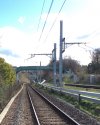Why they didnt go for new locos to drag straight electrics off the wires I dont know. Not dragging a load of diesel kit for most of the day would have been sensible. And enough horses could have been installed in the loco.
So (assuming that GWML electrification reaches Bristol and Oxford) that's...
- Loco at Newark for the Lincoln drag
- Loco at Doncaster for the Hull drag
- Loco at Leeds for the Harrogate drag
- Loco at York for the proposed Middlesbrough drag
- Loco at Newcastle for the Sunderland drag
- A handful of locos at Edinburgh for the Aberdeen/Stirling/ Inverness drags
- A handful of locos at Oxford for the Hereford drags (plus Banbury?)
- A handful of locos at Cardiff for the Swansea/ Pembrokeshire drags
- Lots of locos at Newbury (?) for the Devon/ Cornwall drags
- Loco at Bristol for the Weston drag
(apologies if I've missed any? I'm only including services that have bi-modes, so I'm not counting the pure-diesel GC services to Sunderland/ Bradford Interchange)
All those locos need specialist staff too, so you're going to have them sitting around for long periods
Plus the additional track damage caused by a heavyweight loco, rather than the (relatively) distributed weight of multiple units
Plus the problem of "running round" and all of the additional movements required at stations that have been rationalised for the modern era and no longer have the head shunts/ middle roads/ pointwork they had in the 1980s
Plus the reliability problems that Virgin had when they tried to operate the Holyhead services with 57s dragging 390s west of Crewe
Plus the operational headaches caused by long established diversions (e.g. when the ECML is shut north of Newcastle each October, the trains have to run via the unnelectrified Tyne Valley - similar problems with the "Joint" line through Lincolnshire and other routes), or just the not-uncommon events where the electrification fails but diesel trains can still run
Compared to that, having a handful of engines underneath the multiple unit seems a pretty small price to pay - in fact, given all of the superfluous things that we carry around on trains, it's just another thing on the list (e.g. as mentioned by another poster on the thread, trains only ever use the cab at one end yet we don't have a problem with the weight of a second cab)
Don't get me wrong - I love messy shunting moves - I grew up watching the coupling and splitting of services at 1980s Carstairs - I love a picture of an old loco dragging a modern train over something like Ribblehead - it's fun to see all of the complication - but it's a real operational headache, and we have a busy modern railway that can't accommodate all of this (e.g. does a loco occupy one of the handful of through platforms at Leeds whilst it waits in between Harrogate duties?)

